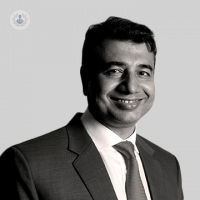Robotic spinal surgery: what you should know
Written in association with:Robotic spinal surgery is when surgeons use robotic technology to assist during surgeries on the spine and back. Though you may feel apprehensive about putting your life in the hands of a robot (though these robots do not have “hands”, per se), the surgeon is still in the room, leading and participating in the procedure. We asked Mr Irfan Malik, consultant spinal and neurosurgeon, to share why he thinks robotic assistance during spinal surgery is an asset when having to navigate the twisty nuances of the spine.

Before this innovative technology was integrated with surgery practices, surgeons would have to operate on the complex and delicate spine guided only by X-rays, their memory of anatomy, and trusting themselves to keep their hands steady. Though doctors train and study for years to become tried-and-true medical professionals, as humans they are still fallible to lapses in memory and judgement, and no one person can truly keep still. Spine surgeries, furthermore, are long, intensive procedures, which means the doctors can lose composure and stamina as the hours tick by.
What are the benefits of robotic spinal surgery?
Robotic assistance helps surgeons due to their unlimited endurance, mathematical precision, and dexterity in accessing difficult-to-reach places along the vertebrae. The robots will have built-in surgical instruments on their “arms”, a control panel for the surgeon, and cameras that provide high-definition, real-time, and colour-accurate imagery of the procedure or anatomy. Having machines that are specifically designed for a role means there is less room for inaccuracy, for example in the placement of spinal screws, which is pivotal to do correctly otherwise there can be paralytic or neurologic damage to the patient. In general, robot assistance means there are smaller incisions and less blood loss, therefore the recovery for the patient is faster.
They can be an aid in small operating spaces, where before there could be crowding from other staff. Robots further help by eliminating the need for invasive manoeuvres to access anatomy, and can greatly cut down the time needed for procedure. Furthermore, robots can take the place of X-ray imaging, meaning less exposure to radiation for the patient, surgeon, and staff.
Robotic assistance has successfully been used in many procedures, such as:
- Spinal fusion
- Tumour excision
- Vertebroplasty
- Vertebral fractures
- Spinal decompression
What are the risks of robotic spinal surgery?
Not every procedure will necessitate robotic assistance, as it depends on the urgency and complexity of the procedure, and some patients may not be suitable due to other considerations. There are risks, as with any surgery or surgeon. Robots are powered by electricity, so should there be a power surge or outage, the robotic assistance would not be usable. The tools could not be appropriately sanitised before the operation. If there is an unexpected complication during the procedure that the robot is not programmed for, then it is just an obstruction in the operating room. There is a learning curve to consider for surgeons working with robotic assistance, which could impact their confidence.
Thankfully, technology evolves at a rapid rate, so there are always improvements to robotic surgical assistance. Hundreds of procedures have been accomplished thanks to robot assistance in the few years it has been available, and we can only imagine the future possibilities.
If you are considering spinal surgery and want to explore your options, Dr Irfan Malik is available for consultation via his Top Doctors profile.


